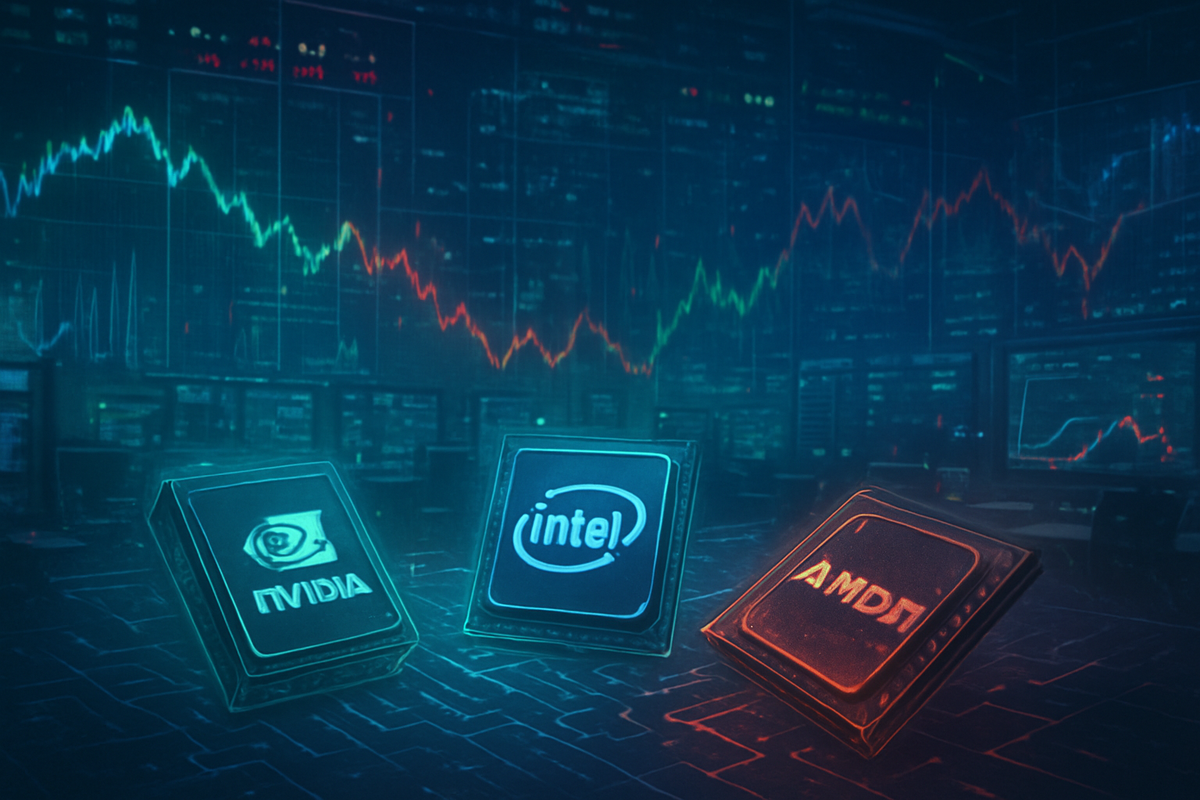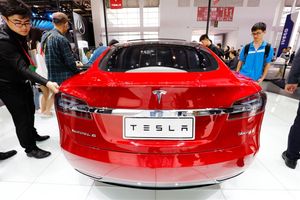
On November 5, 2025, the pre-market trading session presented a complex and largely challenging landscape for major semiconductor stocks, including industry giants Nvidia (NASDAQ: NVDA), Intel (NASDAQ: INTC), and Advanced Micro Devices (NASDAQ: AMD). While some investors might have hoped for a significant bounce back, the reality was a mixed bag characterized by a broader market sell-off, primarily driven by escalating concerns over elevated valuations in the artificial intelligence (AI) sector and a confluence of company-specific news. This immediate downturn signals a growing unease among investors, prompting a re-evaluation of positions within the high-flying tech segment.
The semiconductor industry, a critical backbone of modern technology and the driving force behind the AI revolution, found itself navigating choppy waters. The pre-market movements indicated a significant shift in investor sentiment, moving away from unbridled enthusiasm towards a more cautious, even bearish, outlook. This correction highlights the market's sensitivity to both macroeconomic factors and granular company developments, underscoring the volatile nature of highly valued sectors.
Unpacking the Pre-Market Tumult: A Closer Look at Chip Giants
The early hours of November 5, 2025, saw significant and varied movements among the leading chip manufacturers. Nvidia (NASDAQ: NVDA), a bellwether for the AI boom, experienced a pre-market dip, trading down slightly at $198.68 with substantial volume. This decline was a continuation of a more pronounced sell-off in the previous trading session, where shares fell by as much as 4%. A key catalyst for this renewed pressure was a statement from the White House indicating no interest in facilitating the sale of Nvidia's advanced Blackwell chips to China, a move that immediately triggered concerns over market access and potential revenue impacts for a company with considerable exposure to the Chinese market. This geopolitical overhang amplified existing anxieties about the sustainability of current AI valuations.
In contrast, Intel (NASDAQ: INTC) emerged as a slight outlier, registering a modest pre-market gain, up +0.28 to $40.27. This positive movement, however, followed a substantial 6% drop in the preceding trading session. Intel's relative resilience in the pre-market was buoyed by strategic developments; reports surfaced on November 4 suggesting the company was in preliminary discussions to acquire AI chip designer SambaNova Systems. Such an acquisition is perceived as a strategic maneuver to strengthen Intel's high-margin custom silicon business and accelerate its re-establishment as a leader in the data center sector. Further supporting this sentiment, Tigress Financial reiterated a "Buy" rating and raised its price target for Intel to $52, citing anticipated growth in the AI domain.
Advanced Micro Devices (NASDAQ: AMD) faced a more challenging pre-market, with its stock dropping by approximately 4% to 5%. This decline was particularly noteworthy as it occurred despite AMD reporting robust third-quarter earnings that comfortably surpassed Wall Street expectations, with revenues of $9.25 billion against an $8.75 billion estimate and adjusted earnings of $1.20 per share exceeding the $1.17 forecast. The primary factor dampening investor enthusiasm was AMD's fourth-quarter gross margin guidance of 54.5%, which, while meeting consensus, failed to exceed the elevated expectations of a market increasingly demanding aggressive growth forecasts. Compounding the negative sentiment, Amazon (NASDAQ: AMZN) disclosed that it had divested its entire 822,234-share position in AMD as of September 30, signaling a potential shift in institutional investor confidence.
The immediate implications for the broader semiconductor sector were palpable. The Asian chipmaking stock market experienced an estimated $500 billion erosion in market capitalization on Wednesday, mirroring a similar loss for the Philadelphia Semiconductor Index on Tuesday. This widespread pullback underscored a growing apprehension among investors regarding the earnings potential and currently inflated stock valuations within the sector, especially in an environment where interest rates are expected to remain elevated for an extended period. The Nasdaq 100 futures also registered a decline, with the index recording its sharpest drop in nearly a month, as concerns over lofty valuations intensified.
Winners and Losers: The Shifting Sands of Chip Fortunes
The pre-market movements on November 5, 2025, offer a clear glimpse into the potential winners and losers within the semiconductor landscape, highlighting the intricate interplay of innovation, market sentiment, and strategic positioning.
Nvidia (NASDAQ: NVDA), despite its dominant position in AI accelerators, appears to be facing significant headwinds. The White House's stance on restricting advanced chip sales to China introduces a substantial risk to its future revenue streams, particularly given the importance of the Chinese market for high-end computing. Investors are likely to scrutinize Nvidia's ability to diversify its market presence and mitigate the impact of such geopolitical restrictions. While its technological leadership remains unchallenged, market access limitations could temper its growth trajectory, potentially leading to a re-evaluation of its premium valuation. The company's immediate challenge will be to reassure investors about its long-term growth prospects amidst these external pressures.
Advanced Micro Devices (NASDAQ: AMD), despite delivering strong earnings, found itself in the "loser" category in the immediate pre-market. This highlights a critical aspect of the current market: simply meeting expectations is no longer enough. Investors are demanding outperformance and aggressive guidance, especially from companies whose valuations have surged dramatically. AMD's conservative gross margin guidance for Q4, coupled with Amazon's significant sell-off, suggests that institutional confidence might be wavering slightly, despite the company's impressive year-to-date performance. AMD's future performance will heavily depend on its ability to demonstrate sustained margin expansion and provide more optimistic outlooks to maintain investor enthusiasm in a highly competitive and scrutinized market.
Intel (NASDAQ: INTC), on the other hand, positioned itself as a relative "winner" in this particular pre-market session. Its modest gain, while small, stands out against the broader downturn. This positive reception is largely attributed to its strategic pivot and potential acquisition of SambaNova Systems. Such a move signals Intel's commitment to re-establishing its leadership in the data center and AI segments, areas where it has historically faced stiff competition. The increased price target from Tigress Financial further underscores a renewed confidence in Intel's long-term strategy and its potential to capitalize on the burgeoning AI market. If Intel can successfully integrate new technologies and execute on its strategic roadmap, it stands to regain significant market share and investor trust, potentially challenging the dominance of its rivals in key segments.
Beyond these direct impacts, the broader implications for the semiconductor supply chain are significant. Companies that supply components or services to Nvidia and AMD might experience indirect pressure, while those aligned with Intel's renewed focus on data center AI could see increased demand. This event underscores the market's current discerning nature, rewarding strategic foresight and penalizing even minor deviations from aggressive growth narratives.
Broader Significance: A Reality Check for the AI Rally
The pre-market movements of major chip stocks on November 5, 2025, transcend mere daily fluctuations; they represent a significant reality check for the broader technology market, particularly the exuberant artificial intelligence (AI) rally. This event signals a potential turning point where investor sentiment is shifting from unbridled enthusiasm to a more critical assessment of valuations and sustainable growth.
This downturn fits squarely into a broader industry trend of re-evaluating high-growth, high-valuation stocks. For months, the AI narrative has driven significant capital inflows into companies like Nvidia, pushing their valuations to unprecedented levels. However, as interest rates remain elevated and economic uncertainties persist, investors are becoming increasingly sensitive to earnings misses, conservative guidance, and any signs of market access limitations. The current environment suggests a market that is becoming less forgiving of speculative growth and more focused on tangible profitability and robust forward-looking statements.
The potential ripple effects on competitors and partners are substantial. Companies heavily reliant on the growth of Nvidia's ecosystem, particularly those involved in AI infrastructure or software, could face indirect pressure if Nvidia's growth trajectory is indeed hampered by geopolitical factors. Conversely, Intel's strategic moves, such as the potential acquisition of SambaNova Systems, could signal a more aggressive competitive landscape. If Intel successfully re-establishes its presence in high-margin AI segments, it could intensify competition across the board, potentially affecting the pricing power and market share of existing players. Partners of Intel, especially those in its foundry business or enterprise solutions, could see new opportunities emerge.
Regulatory and policy implications are also at the forefront. The White House's statement regarding advanced chip sales to China underscores the increasing politicization of technology and trade. Such policies can have profound and immediate impacts on the global supply chain and the revenue prospects of multinational corporations. This event serves as a stark reminder that geopolitical tensions can directly translate into market volatility and strategic challenges for tech companies. Investors will now be paying closer attention to trade policies and international relations, recognizing their direct influence on market dynamics.
Historically, periods of rapid technological advancement and market exuberance have often been followed by corrections as valuations become stretched. Comparisons can be drawn to the dot-com bubble of the late 1990s, where speculative investments in internet companies led to inflated valuations, eventually followed by a significant market downturn. While the underlying technology and market fundamentals are vastly different, the current scenario shares a common thread: a market grappling with how to accurately value future growth potential in a rapidly evolving, yet increasingly scrutinized, sector. This event might not be a full-blown collapse, but rather a necessary recalibration, forcing companies and investors alike to adapt to a more discerning market environment.
What Comes Next: Navigating the Evolving Semiconductor Landscape
The mixed pre-market performance of major chip stocks on November 5, 2025, ushers in a period of heightened uncertainty and strategic re-evaluation for the semiconductor industry and the broader tech market. The short-term outlook suggests continued volatility as investors digest the implications of geopolitical tensions, reassess AI valuations, and scrutinize upcoming earnings reports with greater intensity. We can anticipate further price discovery as the market attempts to find a new equilibrium, potentially leading to more significant swings in stock prices for both market leaders and emerging players.
In the long term, this event could catalyze several strategic pivots. Chip manufacturers, particularly those with significant international exposure, may accelerate efforts to diversify their supply chains and market reach to mitigate geopolitical risks. Research and development in alternative markets and applications could become a priority. Companies like Nvidia might explore new growth avenues outside of the most sensitive geopolitical flashpoints, while Intel's renewed focus on strategic acquisitions and domestic manufacturing could gain further momentum. The emphasis will likely shift from pure growth at any cost to sustainable, resilient growth underpinned by diversified operations and robust risk management.
Market opportunities or challenges will undoubtedly emerge from this recalibration. For astute investors, periods of market correction can present buying opportunities in fundamentally strong companies that have been oversold due to broader market sentiment. However, identifying these opportunities will require meticulous due diligence and a deep understanding of each company's long-term prospects, strategic initiatives, and ability to navigate a complex global landscape. Challenges will include navigating increased regulatory scrutiny, managing supply chain disruptions, and adapting to potentially slower growth rates in certain segments of the AI market if the initial hype gives way to more measured adoption.
Potential scenarios and outcomes are varied. One scenario involves a more prolonged period of consolidation and moderate growth for the semiconductor sector, as companies focus on operational efficiency and sustainable innovation rather than aggressive expansion. Another could see a bifurcation of the market, with companies demonstrating clear paths to profitability and resilient business models outperforming, while those with speculative valuations and unproven strategies face continued pressure. The most optimistic scenario would involve a quick market rebound as investors regain confidence, perhaps driven by clearer regulatory guidance or unexpected technological breakthroughs, though this seems less likely given the current headwinds. Ultimately, the coming months will test the resilience and adaptability of the industry's leaders.
Comprehensive Wrap-up: A New Chapter for Chip Investments
The pre-market activity on November 5, 2025, for major chip stocks like Nvidia, Intel, and AMD serves as a pivotal moment, signaling a shift in the financial markets' approach to the high-flying technology sector. The key takeaway is a move away from the unbridled optimism that characterized the early stages of the AI rally towards a more discerning and cautious investment climate. While some individual stocks like Intel showed signs of resilience due to strategic maneuvers, the broader sentiment was one of correction, driven by concerns over inflated valuations, geopolitical risks, and conservative guidance from even top-tier companies.
Moving forward, the market is poised for a period of reassessment. Investors are likely to prioritize companies demonstrating not just innovation, but also robust financial health, clear paths to profitability, and resilience against external shocks. The days of speculative growth being rewarded without immediate tangible returns may be drawing to a close, paving the way for a market that values sustainable business models and prudent management. This shift is not necessarily a negative one; rather, it represents a maturation of the market, forcing companies to refine their strategies and communicate their value propositions more effectively.
The lasting impact of this event will likely be a more disciplined approach to tech investments. It underscores the critical importance of fundamental analysis, risk assessment, and understanding the broader macroeconomic and geopolitical landscapes. For the semiconductor industry, it means a heightened focus on diversification, supply chain resilience, and strategic innovation that can withstand external pressures. The AI revolution is far from over, but its investment narrative is evolving, demanding a more grounded perspective.
Investors should watch for several key indicators in the coming months. These include further developments in US-China tech policy, which could significantly impact companies with global supply chains and customer bases. Quarterly earnings reports will be scrutinized for not just revenue growth, but also margin expansion and realistic forward guidance. Additionally, monitoring interest rate policies and broader economic indicators will be crucial, as these will continue to influence investor appetite for growth stocks. Finally, observing strategic moves by major players, such as acquisitions or new market entries, will provide insights into how the industry is adapting to this new, more challenging environment. The landscape for chip investments is changing, and informed vigilance will be key to navigating its complexities.
This content is intended for informational purposes only and is not financial advice






